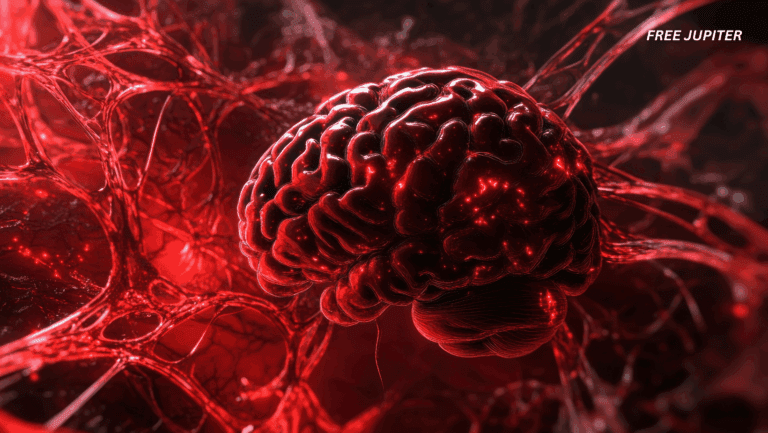Friendly Note: FreeJupiter.com shares general info for curious minds 🌟 Please fact-check all claims—and always check health matters with a professional 💙
A provocative idea is making the rounds in planetary science: if life ever took root on early Mars, it may have accidentally engineered its own extinction. Not through war, pollution, or cosmic bad luck—but through basic metabolism. Picture humble microbes quietly breathing in hydrogen, puffing out methane, and—without any grand plan—nudging a fragile young atmosphere into a deep freeze.
The Setup: Mars Wasn’t Always a Deep-Freeze
Billions of years ago, Mars looked far more welcoming than it does today. It likely had:
- Liquid water on the surface (rivers, lakes, maybe shallow seas)
- A thicker atmosphere that could trap heat
- Chemical ingredients (like hydrogen) that simple life could use as fuel
Enter hypothetical methanogens—microbes similar to some that thrive on Earth in oxygen-free environments. These little chemists “eat” hydrogen and “exhale” methane. On our planet, methane is a potent greenhouse gas. But on early Mars, with its different atmospheric chemistry and delicate temperature balance, that microbial exhaust might have removed warming hydrogen from the air and helped trigger a global cooling spiral.
In short: by chasing energy, the microbes may have tweaked the thermostat in the wrong direction—cooling their own world until it became unlivable.
How Could Microbes Change a Whole Planet?
Two steps:
- They gobbled up hydrogen—a gas that likely helped keep early Mars warm.
- They released methane, which didn’t produce the same warming punch there that it would on Earth. Combined with other atmospheric shifts, this could have thinned and chilled the climate overall.
As temperatures dropped, surface conditions became brutal. Any surviving life would have needed to hide deeper underground, where rock pores, briny pockets, or geothermal warmth could still offer refuge. But over time, even those niches may have disappeared or become too resource-poor to sustain life indefinitely.
Read more: Earth Is Speeding Up—and Timekeepers Are Considering Doing Something They’ve Never Done
Why This Isn’t As Wild As It Sounds: Earth Did Something Similar
Earth has its own cautionary tale: the Great Oxidation Event (GOE), roughly 2.4 billion years ago. Microbes called cyanobacteria invented oxygenic photosynthesis and filled the atmosphere with oxygen—a gas that was toxic to many existing organisms. The GOE forever changed Earth’s chemistry, triggered glaciations, and likely wiped out vast swaths of anaerobic life. Life re-sculpted the planet, and not everyone benefited.
Parallel with Mars: microbes unintentionally remodel the atmosphere → planet-wide climate shock → mass die-off of the very organisms that caused it.
Another Earth Echo: “Snowball Earth”
Earth may also have frozen over nearly entirely during episodes known as Snowball Earth (hundreds of millions of years ago). Different mechanisms were at play (not methanogens here), but the pattern rhymes:
- Small shifts in atmospheric gases and planetary reflectivity
- Runaway cooling
- Life forced into refuges (like near hydrothermal vents or under ice)
These chapters show that planetary climates can be surprisingly unstable, and life doesn’t necessarily prevent catastrophic shifts—it can inadvertently push them.
The Opposite Planetary Fate: Venus as a Greenhouse Runaway
If Mars might have frozen itself via microbial meddling, Venus appears to have taken the opposite road—runaway greenhouse warming, likely without the help of life. Today it’s an inferno: thick CO₂ atmosphere, lead-melting surface temperatures, and crushing pressure.
Together, Mars and Venus sketch out two extremes:
- Mars: thin air, deep freeze
- Venus: thick air, hellish heat
Earth—orbiting in the habitable “Goldilocks zone”—sits between these siblings, constantly juggling feedback loops (biological, geological, and atmospheric) that keep it (so far) relatively stable. The Martian-microbe hypothesis is a reminder that stability is earned, not guaranteed.
Methane on Mars Today: A Mystery Wrapped in a Gas
If ancient methanogens really existed, might any of them (or their chemical fingerprints) still be around?
Scientists have reported sporadic methane detections on modern Mars—famously by NASA’s Curiosity rover—while other instruments (like the ExoMars Trace Gas Orbiter) have sometimes failed to see it. This mismatch is puzzling and controversial. Possible explanations include:
- Seasonal or localized methane bursts
- Methane getting rapidly broken down by sunlight or surface reactions
- Geologic, not biological, sources (e.g., serpentinization, a rock-water reaction that can produce hydrogen and methane)
So far, no detection has been accepted as proof of life, past or present. But the debate itself keeps the story alive: if methane is there, where’s it coming from—and why does it come and go?
Read more: 63 Earths Can Fit Comfortably Inside Uranus
Other Martian “Life Stories” Scientists Keep Revisiting
- ALH 84001: In the 1990s, a Martian meteorite found in Antarctica was claimed to show fossil-like structures. The claim ignited excitement, but most scientists now think these features can be explained by non-biological processes.
- Ancient Lakes & Riverbeds: Orbiters and rovers have mapped deltas, mineral veins, and clays that form in water, suggesting Mars once had long-standing, potentially life-friendly environments.
- Subsurface Ice & Brines: Radar hints at underground ice sheets and possibly salty liquid reservoirs. If anything is still alive, these cold, salty, sunless niches are where we’d expect it to hide.
Beyond Mars: Where Else Could Microbial Life Rewrite the Rules?
- Europa (Jupiter’s moon) & Enceladus (Saturn’s moon): Both have global subsurface oceans, protected by ice. Enceladus even vents plumes containing organic molecules. If life exists there, it might also change local chemistry—though we don’t yet know enough to say how.
- Titan (Saturn’s moon): A world with methane lakes and a hydrocarbon-rich atmosphere. Some scientists wonder if exotic life could thrive in liquid methane and ethane, rewriting our definition of habitability.
- Early Earth itself: Before oxygen took over, methane may have been a key greenhouse gas that kept Earth warm under a dimmer young Sun. Life’s atmospheric tinkering, for better or worse, might be more common than we think.
What Future Missions Should Hunt For
If we truly want to test the “Martian life iced itself” hypothesis, here’s what to look for:
- Isotopic “fingerprints”
Life prefers lighter isotopes. Methane or other gases with unusual isotope ratios might hint at biological origins. - Microfossils or biofilms in ancient rocks
Especially in purported “hotspots” like Hellas Planitia (a deep basin that could have preserved old sediments) or ancient lakebeds explored by rovers. - Organic molecules with biological patterns
Complex, ordered organics (not just simple carbon molecules) or specific lipid-like compounds that life tends to build. - Subsurface habitability
Drill deeper. If anything survived, it’s probably not on the harsh surface, but tucked into rock pores, brines, or geothermal zones. - Better methane monitoring
Higher-precision, globally coordinated atmospheric measurements to clarify whether Mars’ methane stories are biology, geology, or instrumentation quirks.
A Philosophical (But Practical) Takeaway
This isn’t just a fun alien what-if. It’s a climate and ethics story too. Mars—if it once had life that altered its air to death—reminds us that biology and atmosphere are inseparable. On Earth, our species is now doing in a few centuries what natural processes usually take eons to achieve: rewriting the sky.
Key lesson: planets don’t have infinite resilience. Mars and Venus show that climate trajectories can lock in, perhaps permanently. Earth is unusually lucky—but luck is not an excuse for complacency.
Read more: Hundreds of Earthquakes Strike Beneath Major US Volcano, Raising Eruption Fears
The Cosmic Irony That Sticks
If Martian microbes ever existed, they might have been astonishingly successful—for a while. They found energy, multiplied, and gradually changed their world. And in doing so, they pulled the rug out from under themselves.
It’s a strangely poetic image: an entire biosphere undone not by malice or meteors, but by metabolism—life simply doing what life does. The Red Planet may still hold the receipts: chemical whispers in ancient rocks, rare isotopes trapped in minerals, or fossilized microbial mats waiting in long-buried sediments.
Until we know for sure, the story serves as both inspiration and quiet warning. Life is powerful. Planets are sensitive. And destiny—planetary or biological—is often written in the air.










